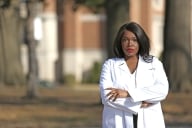You have /5 articles left.
Sign up for a free account or log in.

wenmei_zhou
Leadership skills can contribute significantly to creating and maintaining constructive relationships between faculty members and students. In a previous article, we've explored how self-aware academic leaders assess their strengths and deploy them to motivate and inspire those in their unit. Here, we examine how self-aware faculty members can cultivate a more inclusive environment for students and model different ways of solving intradepartmental issues.
Administrative and faculty leaders wear many hats within a department, and it’s important to think about ways to provide guidance to students despite departmental conflicts. Self-aware academic leaders mentor students through these issues and resolve them without involving those students.
A prime example of the importance of such leadership skills is when faculty members in a department or on a committee are in conflict with each other. Such conflict can happen for a number of reasons, such as clashes of strong egos and personalities, disputes about different paradigmatic or theoretical approaches to research, or frictions growing out of different political or ideological orientations (often exacerbated by antagonistic identity positions). Or, as is frequently the case, they can arise due to a confluence of more than one of those circumstances.
For example, in the department of one of us, at one time, there was a contested tenure case that pitted faculty members vehemently against one another. In a mix of personality clashes and principled differences of academic judgment, the department was deeply split. Many doctoral students at that time had advisory committees with members from both camps and were worried that their own cases would become fodder in the wider battle.
But faculty never did that: in their dealings with uncertain and vulnerable doctoral students, they were unfailingly professional and fair, whatever else was going on between them in that wider context. Imagine a hypothetical department where students were expected to take sides and student allies of some faculty were not able to get support, advisement or recommendations from the others.
Such hypothetical conflicts can often seem “principled,” in the sense that adversaries see them as the working out of substantive positions and values. Faculty who would never put students in the middle of a purely personal dispute often do see it as appropriate to expect students to take sides on an argument over what they characterize as fundamental scholarly, social or political commitments. Sometimes students may be all too eager to take part, because of their own positions on those issues. But that can be dangerous and possibly damaging to students, because it is not in their interests to become potential pawns in a faculty-to-faculty conflict.
Asymmetrical Relationships
If you are a faculty member working with students, always recognize that the relationship is not symmetrical. You as the leader, the mentor, the guide and the role model have the greater responsibility to steer the conversation in a productive direction. You must remain aware of whom you are mentoring and set a standard in how to handle difficult conversations. Your students will observe and judge everything you do and say. They are learning from you what it means to be a professor and a leader, and you must keep that in mind. Sometimes it is harder to do this than others: when a high degree of emotion is connected with a subject matter, when theoretical and/or political differences color the way an issue is framed, or when the topic entails wider controversy or a challenge to authority. Nevertheless, a teacher is always a teacher.
To help alleviate any spillover to students during a faculty conflict, you should stop and reflect upon the situation. Where is this issue really coming from, and what gives it its energy? Reflection provides an opportunity to consider the sources of conflict and the nature of your involvement. Conflicts are not always -- or not only -- about what they first seem to be about.
For example, imagine a hiring decision that gets overturned because the candidate falsified significant information in their application. The candidate also claims to be to be a member of an underrepresented group. To the outside world, this looks like a case of potential discrimination, when in fact, it has nothing to do with that, and any candidate, regardless of their identity position, would have been treated the same way. But because the department for legal reasons can’t disclose the details of the application, or its falsehoods, they will always be on the defensive in trying to explain the decision. Nor is it always clear, as recent events have revealed, that identity claims can be trusted at face value.
Therefore, keeping an eye on the salient issues and not the distractions is crucial. Here, too, students will be looking to you as an example. Considering your own actions, and how other people respond to them, may point to areas where changes under your control -- such as how you conduct yourself as a responsible leader -- may be especially important. That can strengthen your mentorship and protect students from what might become unanticipated consequences of their involvements as partisans on one side or another of a departmental dispute.
Remember, too, that your public comments -- including, by the way, public emails and social media posts -- can have especially disproportionate effects on students. Self-aware leaders can use reflection to assess goals and achievable outcomes and to create intentional strategies for reducing immediate and long-term conflict.
The unfortunate fact is that, for some faculty members, taking such public positions and activating students to join in is an expression of their own views on leadership and professional responsibility. It is, for them, as we mentioned earlier, a matter of principle. They may view it as paternalistic to think that adult students can’t decide for themselves whether to participate in department controversies -- or worse, an infringement of their rights to protest. Without engaging this attitude in depth, we will only say here that the stakes of involvement in such cases are asymmetrical, and that faculty members -- especially those with the protections of tenure -- view these situations from a position that students can only still aspire to.
Reflection can strengthen your self-awareness as well as that of other members of the unit. If you are willing to offer, hear and engage points of view that might be uncomfortable to you, then students and others may be more likely to follow suit. Conversely, if you lose perspective or violate professional standards of conduct, students will see that, as well.
In fact, how we deal with these matters, and how students see us deal with them, communicates more about our educational priorities than anything we overtly say. Students who are considering a career in academe are learning every day what it means to conduct oneself as a faculty member and leader. We must make sure their lessons are the right ones.








